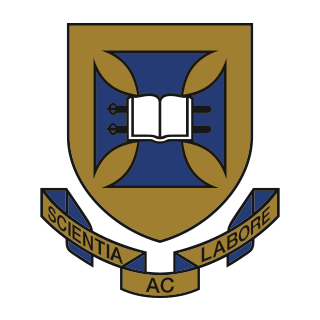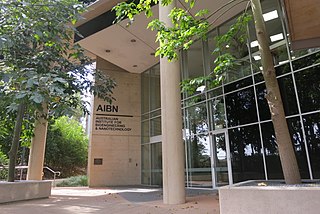Related Research Articles

The University of Queensland is a public research university located primarily in Brisbane, the capital city of the Australian state of Queensland. Founded in 1909 by the Queensland parliament, UQ is one of the six sandstone universities, an informal designation of the oldest university in each state. UQ is also a founding member of edX, Australia's leading Group of Eight and the international research-intensive Association of Pacific Rim Universities.

Riversleigh World Heritage Area is Australia's most famous fossil location, recognised for the series of well preserved fossils deposited from the Late Oligocene to more recent geological periods. The fossiliferous limestone system is located near the Gregory River in the north-west of Queensland, an environment that was once a very wet rainforest that became more arid as the Gondwanan land masses separated and the Australian continent moved north. The approximately 100 square kilometres (39 sq mi) area has fossil remains of ancient mammals, birds, and reptiles of the Oligocene and Miocene ages, many of which were discovered and are only known from the Riversleigh area; the species that have occurred there are known as the Riversleigh fauna.

The VS-30 is a Brazilian sounding rocket, developed by the Instituto de Aeronáutica e Espaço and derived from the Sonda 3 sounding rocket first stage. It consists of a single, solid-fuelled stage, and has been launched from Alcântara, Maranhão and Barreira do Inferno, Rio Grande do Norte, in Brazil, and Andøya and Svalbard Rocket Range in Norway.

The UQ Law School is the law school of the University of Queensland in Brisbane, Australia. Founded in 1936, UQ law school is the sixth oldest law school in Australia and the oldest operating in Queensland.

The University of Queensland Library provides library access to students of the University of Queensland in Brisbane. It developed from a small provincial university library into a major research library. It was first housed in the Old Government House building of George Street from 1911 to 1923. From 1923 to 1948, it was housed in the Art Block of the Central Technical College in George Street, next to the university. In late 1948, the library moved to the new St Lucia campus, residing in the Duhig Building. By 1954, it had already exceeded its capacity.

The University of Queensland's Australian Institute for Bioengineering and Nanotechnology (AIBN) was established in 2003. It is one of four stand-alone research institutions at the university with more than 500 researchers, students and support staff. The inaugural Director was Peter Gray. The institute's second director, Professor Alan Rowan, commenced in 2016.

Gaoqing Max LuFREng FIChemE, FRSC is a Chinese–Australian chemical engineer and nanotechnologist. He is the current Vice-Chancellor of the University of Surrey.
Mark A. F. Kendall is an Australian biomedical engineer, inventor, scientist and entrepreneur.
ProfessorJulie Hazel Campbell AO FAA is an Australian vascular biologist specialising in vascular smooth muscle. She is a professional fellow at the Australian Academy of Science and holds two patents for vascular implant material. Campbell made a groundbreaking discovery in the early 1970s, revealing that smooth muscle cells possess various phenotypes that regulate their biology and reaction to disease triggers, such as heart disease. Additionally, she uncovered methods to sustain these cells in a non-disease state. This newfound knowledge significantly advanced the comprehension of atherosclerotic plaque formation and offered valuable insights into potential preventive measures.

Mary Jacquiline Romero is a quantum physicist in the Australian Research Council Centre of Excellence for Engineered Quantum Systems at the University of Queensland, Australia. Her research expertise and interests are in the field of quantum foundations and quantum information. In particular, Romero is an experimental quantum physicist studying the properties of single photons for the development of new quantum alphabets and the nature of quantum causality.
Warwick Bowen is an Australian quantum physicist and nanotechnologist at The University of Queensland. He leads the Quantum Optics Laboratory, is Director of the UQ Precision Sensing Initiative and is one of three Theme Leaders of the Australian Centre for Engineered Quantum Systems.
Karen H. Black, born about 1970, is a palaeontologist at the University of New South Wales. Black is the leading author on research describing new families, genera and species of fossil mammals. She is interested in understanding faunal change and community structure in order to gain new understandings of past, current and future changes in biodiversity which are driven by climate.
Professor Wendy Elizabeth Hoy AO is a Fellow of the Australian Academy of Science (FAA), the Director of the Centre for Chronic Disease at the University of Queensland, Australia, and was appointed an Officer of the Order of Australia (AO) in 2010 and elected as a member of the Australian Academy of Science in 2015. Hoy's research has involved developing new types of kidney imaging and improving health and lives for indigenous populations, in Australia, Sri Lanka and the USA.
Geraldine Fitzpatrick is an Australian professor and academic researcher who serves as the head of the Human-Computer Interaction Group at TU Wien since 2009. Her research is interdisciplinary at the intersection of social and computer sciences.
The Australian Research Council (ARC) Centre of Excellence for Plant Success in Nature and Agriculture is a research centre that combines plant science, mathematics, genetics, agriculture, and law to learn more about what makes plants successful in different environments. The Centre aims to develop new, more effective ways of solving persistent problems in plant science by predicting and improving plant performance in diverse environments. Using quantitative and computational methods the Centre for Plant Success will link gene networks with traits to help address the problems of food security and climate change.

Helen Margaret Stallman is an Australian scientist, clinical psychologist and author. She is director of the International Association of University Health and Wellbeing.
Sean Smith is the director of NCI Australia with a conjoint position of professor of computational nanomaterials science and technology at the Australian National University (ANU).
Makenzie Weale is an Australian professional rugby league footballer who currently plays for the North Queensland Cowboys in the NRL Women's Premiership.
Ryan Donald Bayldon-Lumsden is an Australian former politician who served as a member of the Gold Coast City Council from 2020 until 2024. He was suspended from council on 15 September 2023 after being charged with the murder of his stepfather.
Maren Dammann is a German scientist and novelist. She writes both adult and adolescent fiction.
References
- ↑ Wang, Lianzhou; Sasaki, Takayoshi; Ebina, Yasuo; Kurashima, Keiji; Watanabe, Mamoru (2002). "Fabrication of Controllable Ultrathin Hollow Shells by Layer-by-Layer Assembly of Exfoliated Titania Nanosheets on Polymer Templates". Chemistry of Materials. 14 (11): 4827–4832. doi:10.1021/cm020685x.
- ↑ Omomo, Yoshitomo; Sasaki, Takayoshi; Wang; Watanabe, Mamoru (2003). "Redoxable Nanosheet Crystallites of MnO2 Derived via Delamination of a Layered Manganese Oxide". Journal of the American Chemical Society. 125 (12): 3568–3575. doi:10.1021/ja021364p. PMID 12643719.
- ↑ Wang, Lianzhou; Sasaki, Takayoshi (8 October 2014). "Titanium Oxide Nanosheets: Graphene Analogues with Versatile Functionalities". Chemical Reviews. 114 (19): 9455–9486. doi:10.1021/cr400627u. ISSN 0009-2665. PMID 24754464.
- ↑ "Nanomaterials Centre". Nanomaterials Centre. Retrieved 1 February 2019.
- ↑ "Lianzhou Wang". Member. Academia Europaea. Retrieved 20 October 2024.
- ↑ Lu, Gao Qing (Max); Cheng, Hui-Ming; Yang, Hua Gui; Wang, Lianzhou; Liu, Gang (19 January 2010). "Titania-based photocatalysts—crystal growth, doping and heterostructuring". Journal of Materials Chemistry. 20 (5): 831–843. doi:10.1039/B909930A. ISSN 1364-5501.
- ↑ Mukherji, Aniruddh; Seger, Brian; Lu, Gao Qing (Max); Wang, Lianzhou (24 May 2011). "Nitrogen Doped Sr2Ta2O7 Coupled with Graphene Sheets as Photocatalysts for Increased Photocatalytic Hydrogen Production". ACS Nano. 5 (5): 3483–3492. doi:10.1021/nn102469e. ISSN 1936-0851. PMID 21488687.
- ↑ Zong, Xu; Han, Jingfeng; Seger, Brian; Chen, Hongjun; Lu, Gaoqing (Max); Li, Can; Wang, Lianzhou (2014). "An Integrated Photoelectrochemical–Chemical Loop for Solar-Driven Overall Splitting of Hydrogen Sulfide". Angewandte Chemie. 126 (17): 4488–4492. Bibcode:2014AngCh.126.4488Z. doi:10.1002/ange.201400571. ISSN 1521-3757.
- ↑ Wang, Lianzhou; Lu, Gao Qing (Max); Amal, Rose; Li, Zhen; Yu, Hua; Bai, Yang (14 November 2012). "In Situ Growth of a ZnO Nanowire Network within a TiO2 Nanoparticle Film for Enhanced Dye‐Sensitized Solar Cell Performance". Advanced Materials. 24 (43): 5850–5856. Bibcode:2012AdM....24.5850B. doi:10.1002/adma.201201992. ISSN 1521-4095. PMID 22930471. S2CID 26131765.
- ↑ "Structure Meets Function at the Nanoscale: AIBN's Professor Lianzhou Wang makes advances in rechargeable battery technologies". Australian Institute for Bioengineering and Nanotechnology. 26 July 2017. Retrieved 1 February 2019.
- ↑ "Lianzhou Wang - Google Scholar Citations". scholar.google.com.au. Retrieved 1 February 2019.
- ↑ "Professor Lianzhou Wang". UQ Researchers. The University of Queensland. Retrieved 2 June 2024.
- ↑ Queensl, The University of; Lucia, Australia Brisbane St; Gatton, QLD 4072 +61 7 3365 1111 Other Campuses: UQ; Maps, UQ Herston; Queensl, Directions © 2019 The University of. "UQ research finds a little bit of sunshine gives clean water". UQ News. Retrieved 1 February 2019.
{{cite web}}: CS1 maint: numeric names: authors list (link) - ↑ Queensl, The University of; Lucia, Australia Brisbane St; Gatton, QLD 4072 +61 7 3365 1111 Other Campuses: UQ; Maps, UQ Herston; Queensl, Directions © 2019 The University of. "Nanotech key to sustainability for UQ Scopus award winner". UQ News. Retrieved 1 February 2019.
{{cite web}}: CS1 maint: numeric names: authors list (link) - ↑ "The winner of "Top Papers Award" in 2018". www.springer.com. Retrieved 1 February 2019.
- ↑ Queensl, The University of; Lucia, Australia Brisbane St; Gatton, QLD 4072 +61 7 3365 1111 Other Campuses: UQ; Maps, UQ Herston; Queensl, Directions © 2019 The University of. "Awards celebrate UQ's research stars". UQ News. Retrieved 1 February 2019.
{{cite web}}: CS1 maint: numeric names: authors list (link) - ↑ "UQ celebrates new ARC Laureate Fellows". University of Queensland . 13 September 2019. Retrieved 2 May 2020.
- ↑ "Academy announces 2024 Fellows for outstanding contributions to science". Australian Academy of Science. Retrieved 22 May 2024.